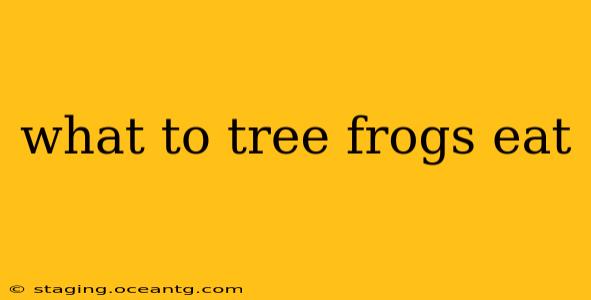Tree frogs, with their vibrant colors and captivating calls, are fascinating creatures. But what exactly do these arboreal amphibians consume? Their diet is surprisingly diverse and depends heavily on their specific species and habitat. Understanding their eating habits is key to appreciating their role in the ecosystem and ensuring their well-being.
What are the main components of a tree frog's diet?
The foundation of a tree frog's diet consists primarily of insects. This isn't surprising, considering their size and hunting capabilities. However, the types of insects vary widely. Expect to find them feasting on:
- Crickets: A staple food source, readily available and easy to catch.
- Grasshoppers: Another common prey item, particularly in areas with abundant vegetation.
- Moths and Butterflies: These flying insects provide a source of protein and are often caught at night.
- Flies: A diverse group of insects that tree frogs readily consume.
- Ants: Smaller, but abundant, ants provide a significant portion of a tree frog's diet.
- Beetles: Various beetle species, depending on availability in the environment.
- Spiders: While technically arachnids, spiders are often part of their diet.
Do tree frogs eat anything other than insects?
While insects make up the bulk of their diet, some larger tree frog species may occasionally consume other small creatures like:
- Small lizards: This is more common in larger species.
- Small snakes: Again, more prevalent among larger tree frog species.
- Other frogs: Cannibalism, while uncommon, has been observed in certain species.
The size and type of prey will also depend on the size of the tree frog itself. A smaller species will naturally target smaller insects, whereas a larger species will be capable of hunting larger prey.
What do tree frog tadpoles eat?
The diet of tree frog tadpoles differs significantly from that of adult frogs. Tadpoles are primarily herbivores and detritivores, feeding on:
- Algae: This forms the basis of their diet, providing essential nutrients.
- Decaying plant matter: They help break down organic debris in their aquatic environment.
- Zooplankton: Tiny aquatic organisms that contribute to their nutrition.
- Bacteria: Microscopic organisms that can provide nutrients.
As they develop and metamorphose into adult frogs, their diet gradually shifts from plant-based to insect-based.
How do tree frogs catch their prey?
Tree frogs are ambush predators, meaning they wait patiently for their prey to come within striking distance. They use their long, sticky tongues to capture insects with remarkable speed and accuracy. Their eyes, often positioned to provide excellent binocular vision, play a crucial role in locating and tracking prey.
What are some common misconceptions about tree frog diets?
A common misconception is that all tree frogs eat the same things. As highlighted above, diet varies significantly depending on species, age, and habitat. Another misconception is that tree frogs require only one type of insect for sustenance. A varied diet is crucial for their overall health and well-being.
How can I feed my pet tree frog?
If you keep tree frogs as pets, remember that a varied diet is vital for their health. Offer a mix of appropriately sized insects, such as crickets, mealworms, and waxworms. Supplementing their diet with calcium and vitamin dust is crucial. Always research the specific dietary needs of your tree frog species before selecting food.
This comprehensive guide should help you better understand the diverse and fascinating world of tree frog nutrition. Remember that responsible observation and understanding of their natural habits are essential for the conservation of these amazing creatures.
